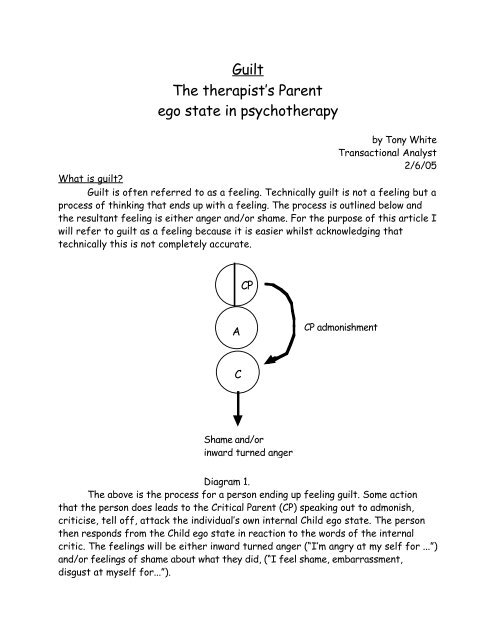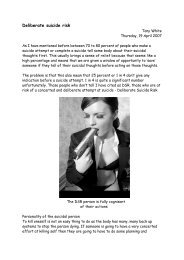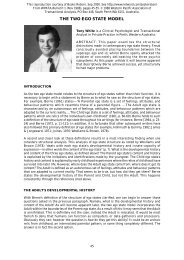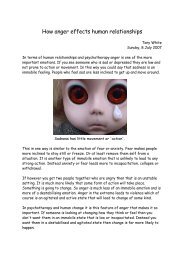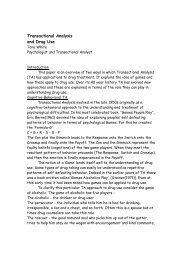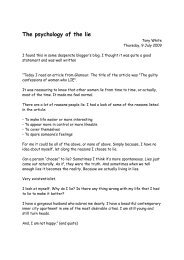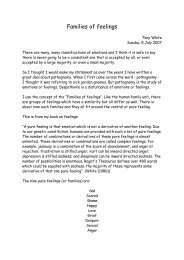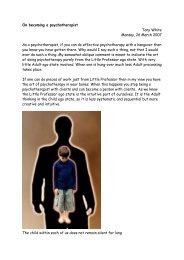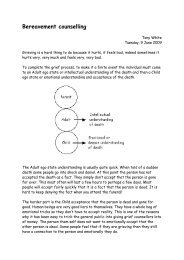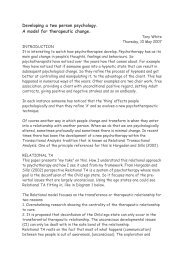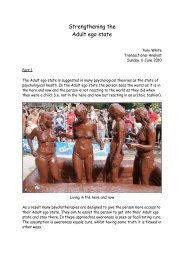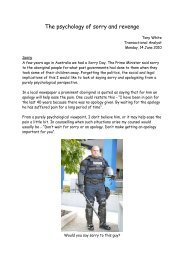Guilt The therapist's Parent ego state in psychotherapy - Tony White
Guilt The therapist's Parent ego state in psychotherapy - Tony White
Guilt The therapist's Parent ego state in psychotherapy - Tony White
Create successful ePaper yourself
Turn your PDF publications into a flip-book with our unique Google optimized e-Paper software.
<strong>Guilt</strong><strong>The</strong> therapist’s <strong>Parent</strong><strong>ego</strong> <strong>state</strong> <strong>in</strong> <strong>psychotherapy</strong>by <strong>Tony</strong> <strong>White</strong>Transactional Analyst2/6/05What is guilt?<strong>Guilt</strong> is often referred to as a feel<strong>in</strong>g. Technically guilt is not a feel<strong>in</strong>g but aprocess of th<strong>in</strong>k<strong>in</strong>g that ends up with a feel<strong>in</strong>g. <strong>The</strong> process is outl<strong>in</strong>ed below andthe resultant feel<strong>in</strong>g is either anger and/or shame. For the purpose of this article Iwill refer to guilt as a feel<strong>in</strong>g because it is easier whilst acknowledg<strong>in</strong>g thattechnically this is not completely accurate.CPACP admonishmentCShame and/or<strong>in</strong>ward turned angerDiagram 1.<strong>The</strong> above is the process for a person end<strong>in</strong>g up feel<strong>in</strong>g guilt. Some actionthat the person does leads to the Critical <strong>Parent</strong> (CP) speak<strong>in</strong>g out to admonish,criticise, tell off, attack the <strong>in</strong>dividual’s own <strong>in</strong>ternal Child <strong>ego</strong> <strong>state</strong>. <strong>The</strong> personthen responds from the Child <strong>ego</strong> <strong>state</strong> <strong>in</strong> reaction to the words of the <strong>in</strong>ternalcritic. <strong>The</strong> feel<strong>in</strong>gs will be either <strong>in</strong>ward turned anger (“I’m angry at my self for ...”)and/or feel<strong>in</strong>gs of shame about what they did, (“I feel shame, embarrassment,disgust at myself for...”).
<strong>The</strong> feel<strong>in</strong>gs can either come from CC (Conform<strong>in</strong>g Child) as <strong>in</strong> the case ofneurotic guilt or from the FC (Free Child) as <strong>in</strong> the <strong>in</strong>stance of appropriate guilt.Appropriate guilt is a natural emotion that allows society to function. <strong>The</strong>re can beno society without guilt. It keeps the Free Child <strong>ego</strong> <strong>state</strong> <strong>in</strong> check and that allowssociety to evolve. If the Free Child wants money then he will go and take it. For ayoung child that may <strong>in</strong>clude steal<strong>in</strong>g her brother’s piggy bank and tak<strong>in</strong>g the money.If the child has been raised <strong>in</strong> a reasonably successful way then the child will feelguilt about steal<strong>in</strong>g her sibl<strong>in</strong>g’s money, As the feel<strong>in</strong>g of guilt is an unpleasant onethen the child <strong>in</strong> the future will tend not to do it aga<strong>in</strong> and thus that m<strong>in</strong>i-societyof the family can function. This would be considered appropriate guilt that hasbeneficial long term results.Neurotic guilt is what is commonly presented by clients <strong>in</strong> the counsell<strong>in</strong>gsession. This guilt is not appropriate for the society that the person lives <strong>in</strong>. If aperson feels angry at his mother for what was unfair treatment and expresses thatanger then that person may subsequently feel guilt. If this person was raised withthe <strong>in</strong>junction of “Don’t show your anger” then they could feel guilt after such anexpression of feel<strong>in</strong>g. Indeed guilt can result after the break<strong>in</strong>g of any <strong>in</strong>junctionby the <strong>in</strong>dividual.Why is guilt a wide spread problem?I observed a woman the other day who had parked her car at the local shopsand had a 3 year old child <strong>in</strong> the back seat of the car. <strong>The</strong> woman had alighted thecar and was want<strong>in</strong>g to go about her bus<strong>in</strong>ess but the child was dawdl<strong>in</strong>g, tak<strong>in</strong>g histime and mov<strong>in</strong>g very slowly gett<strong>in</strong>g out of the car. <strong>The</strong> woman was frustrated atthis and was tell<strong>in</strong>g him to hurry up. She then began to just walk away (<strong>in</strong> a pretendfashion) from the car leav<strong>in</strong>g the child there and say<strong>in</strong>g th<strong>in</strong>gs like. “Mummy is go<strong>in</strong>gnow and I’ll leave you here.” <strong>The</strong> child howled <strong>in</strong> protest and reluctantly hurried up abit more. <strong>The</strong> mother aga<strong>in</strong> gestured to move away and the child eventually,reluctantly hurried up and chased after mother.Why would this woman do such a th<strong>in</strong>g? Because she has unconsciously learnt,like all parents do, that human’s have a genetically <strong>in</strong>built aversion to abandonmentby a parent or primary carer. It does not take long for children to realise that if aparent leaves them (abandons them), then that is very frighten<strong>in</strong>g th<strong>in</strong>g <strong>in</strong>deed (to bealone <strong>in</strong> the big wide world) and ultimately life threaten<strong>in</strong>g (if the parents leavethen the child will eventually die as it does not yet have the Adult <strong>ego</strong> <strong>state</strong> to beable to competently look after itself with food, shelter and security.)So this woman was <strong>in</strong> one way an amateur psychologist. She was us<strong>in</strong>g herobservation about the genetically <strong>in</strong>built fear of abandonment <strong>in</strong> children and us<strong>in</strong>gthat fear to get her son to conform and behave <strong>in</strong> the way she wanted. This is a veryeffective way of gett<strong>in</strong>g children to conform as the fear of abandonment is very
strong <strong>in</strong> human nature. <strong>The</strong> problem is that it has unfortunate side effects for thechild <strong>in</strong> later life.A child who is subject to these k<strong>in</strong>d of threats consistently <strong>in</strong> childhood canoften develop a permanent fear of abandonment. So <strong>in</strong> adulthood he may formrelationships where he is cl<strong>in</strong>gy to his partner because he fear she may leave asmother always threatened to do. And then this ‘cl<strong>in</strong>gy’ type behaviour can be a set upthat ‘pushes’ the partner away (she feels smothered) and the partner eventuallyleaves the relationship. <strong>The</strong> <strong>in</strong>dividual can then th<strong>in</strong>k script th<strong>in</strong>gs like, “It justgoes to show you that people always abandon me just like mother threatened to do.”I have digressed a bit here but the purpose of the exercise is to show howsome people have learnt about some of the frailties of human nature like the fear ofabandonment and use them now for some particular reason. <strong>Guilt</strong> is no different.<strong>Guilt</strong> can be a strong and pa<strong>in</strong>ful emotion that can make people modify theirbehaviour. Thus parents have observed human nature and learnt that they can makeJenny behave <strong>in</strong> a certa<strong>in</strong> way if they can get her to feel guilty about a piece ofbehaviour. Thus she will avoid do<strong>in</strong>g it and do other behaviour that the parent wantsher to do. For <strong>in</strong>stance if parents’ can conv<strong>in</strong>ce their daughter’s Critical <strong>Parent</strong>that it is bad, shameful and a s<strong>in</strong> to have premarital sex then they know that thedaughter is more likely to behave <strong>in</strong> a chastely manner because she will feel the pa<strong>in</strong>of guilt afterwards. Thus the behaviour is modified through us<strong>in</strong>g the power of guiltthat is naturally <strong>in</strong> all of us.Counsell<strong>in</strong>g the guilt ridden client.So it would seem that the first step <strong>in</strong> counsell<strong>in</strong>g such clients is for thetherapist to diagnose the guilt as either neurotic guilt or appropriate guilt. <strong>The</strong>paths taken to treat either type of guilt are very different. Sometimes it is not aneasy task to make such a diagnosis. Over the years of counsell<strong>in</strong>g parents one comesacross the situation where a mother feels some guilt about go<strong>in</strong>g <strong>in</strong>to her sonJimmy’s room and through his personal stuff look<strong>in</strong>g for cigarette’s or marijuanawhilst 13 year old Jimmy is at school.Is this appropriate or neurotic guilt? On the one hand the mother violatedher son’s privacy and trust and thus the guilt is appropriate. On the other hand shewas look<strong>in</strong>g through his stuff because she feared he was behav<strong>in</strong>g dangerously, soher actions were for his long term benefit. Does that make it OK and thus the guiltis neurotic?In most cases the l<strong>in</strong>e between appropriate and neurotic guilt is a bit moreclear than this scenario. With neurotic guilt the treatment plan is relatively clear.One deals with the <strong>in</strong>appropriate Critical <strong>Parent</strong> message <strong>in</strong> the clients head. For<strong>in</strong>stance the message may be: “You are bad and should feel guilty for be<strong>in</strong>g assertivewith your mother”.
<strong>The</strong> counsellor br<strong>in</strong>gs this to the clients awareness <strong>in</strong> some way, then theremay be some decontam<strong>in</strong>ation, followed by the mak<strong>in</strong>g of new <strong>Parent</strong> messages aboutthe issue of assertion and there may be some regressive work by such means as twochair redecision work.<strong>The</strong> situation is more difficult when the client’s guilt is appropriate. Fromwhat I have seen the great majority of therapists either ignore such situations orgloss over it <strong>in</strong> some way. If the guilt is appropriate then the therapist is say<strong>in</strong>gfrom their <strong>Parent</strong> <strong>ego</strong> <strong>state</strong>: “You should feel guilty”. From what I have seen veryfew therapists are will<strong>in</strong>g to br<strong>in</strong>g their own Critical <strong>Parent</strong> <strong>ego</strong> <strong>state</strong> <strong>in</strong>to thecounsell<strong>in</strong>g room. It is easy to understand why therapists are reluctant to do this.First many are tra<strong>in</strong>ed to keep their own values out of the clients counsell<strong>in</strong>gsession, <strong>in</strong>stead they are <strong>in</strong>structed to accept the client unconditionally. Second if atherapist relates to the client from her Critical <strong>Parent</strong> <strong>ego</strong> <strong>state</strong> then that cancause considerable problems with the client’s transference to the therapist. So forreasons such as these, from what I have seen, most therapists <strong>in</strong> some way avoid aclients appropriate guiltHowever this raises the question of are we damag<strong>in</strong>g our clients (or at leastdo<strong>in</strong>g them a disservice) by not confront<strong>in</strong>g them with their appropriate guilt. As weknow all healthy people have feel<strong>in</strong>gs of appropriate guilt and the competenttherapist would need to acknowledge this <strong>in</strong> the client.Case examplesNumber 1I was recently deal<strong>in</strong>g with a client who was hav<strong>in</strong>g an affair and she <strong>state</strong>dto me: “I am cheat<strong>in</strong>g on my husband and feel guilty about it.” In our society mostwould consider this an <strong>in</strong>stance of appropriate guilt and the competent therapist hasall three <strong>ego</strong> <strong>state</strong>s <strong>in</strong> operation and they may say th<strong>in</strong>gs like:PYou should feel guilty about thatAThat is appropriate guiltCI’m glad you feel guilt
Diagram 2.Aga<strong>in</strong> I would suggest that very few therapists would say such th<strong>in</strong>gs. Mostwould say someth<strong>in</strong>g like: many an affair is an unsophisticated, childlike attempt toresolve a very difficult emotional situation. <strong>The</strong> affair represents the Child <strong>ego</strong><strong>state</strong> say<strong>in</strong>g that it wants to be out of the marriage and thus the woman has asexual relationship with another man. At the same time another part of the Child<strong>ego</strong> <strong>state</strong> says it is too frighten<strong>in</strong>g to be out of the marriage so I will keep it asecret. An <strong>in</strong> between solution. By say<strong>in</strong>g this (ie by be<strong>in</strong>g understand<strong>in</strong>g of theclient) and omitt<strong>in</strong>g to say what is <strong>in</strong> diagram 2 the therapist is giv<strong>in</strong>g permission tothe client to have an affair. It is <strong>in</strong> essence putt<strong>in</strong>g the client <strong>in</strong> a position whereit is easier for her to feel guilt free about the affair. If she feels less guiltyabout that then she is <strong>in</strong> a position to more freely have further affairs and thusbreak the trust and monogamy contract she has with her husband.Number 2.A client <strong>in</strong> his mid 30s reveals that he has stolen a significant amount ofmoney. Well over a hundred thousand dollars. He stole it from a large organisationand thus as he says it was a victimless crime. Whilst there is always a victim <strong>in</strong>cases like this there is not a clearly identifiable person as a victim.Enough time has past now so that f<strong>in</strong>ancial records have been destroyed andso he will never be caught for it. He was just pla<strong>in</strong> lucky a detailed audit was neverdone. He now reports that he views himself as a thief and feels guilt about it.How does a therapist respond to this. In our society it is appropriate guiltand thus his guilt is Free Child - a natural human reaction. So he is th<strong>in</strong>k<strong>in</strong>g andfeel<strong>in</strong>g appropriately, so there is not a contam<strong>in</strong>ation, an exclusion or any magicalth<strong>in</strong>k<strong>in</strong>g <strong>in</strong>volved.What does the therapist do?. Few would br<strong>in</strong>g their <strong>Parent</strong> <strong>ego</strong> <strong>state</strong> <strong>in</strong>to thesituation and conclude that the client’s guilt was good and appropriate. By omitt<strong>in</strong>gto do this the therapist is giv<strong>in</strong>g permission to be guilt free <strong>in</strong> a situation wherethe guilt is appropriate. Thus the therapist is encourag<strong>in</strong>g and strok<strong>in</strong>g pathologicalbehaviour. It would seem that therapists need to learn how to br<strong>in</strong>g their own<strong>Parent</strong> <strong>ego</strong> <strong>state</strong> <strong>in</strong>to the therapy sett<strong>in</strong>g whilst at the same time avoid<strong>in</strong>g thenegative transferential effects that can result from that.Besides this however I still had a client <strong>in</strong> front of me who was feel<strong>in</strong>g guiltand was want<strong>in</strong>g to do someth<strong>in</strong>g about that. How does one do that with appropriateguilt. What is the psychologically healthy way of deal<strong>in</strong>g with it.Is he just meant to suffer <strong>in</strong> the pa<strong>in</strong> of the guilt?. Is it appropriate to paysome form of penance?. If he owned up to it and took his punishment then the guiltwould probably subside. <strong>The</strong> punishment <strong>in</strong> this <strong>in</strong>stance would probably be prison. Hementioned that he could donate it all anonymously to a charity and that would
alleviate the guilt. Or the other solution is simply time. As we know, over timefeel<strong>in</strong>gs tend to subside and guilt is no different than any other feel<strong>in</strong>g <strong>in</strong> this way.He could acknowledge what he has done and the resultant guilt and thus note that hewill not do it aga<strong>in</strong>, which I believe is the solution he has taken.I don’t know what is the correct solution. I do know that he ga<strong>in</strong>ed awarenessthat it was appropriate guilt and I do know that he is aware of the various coursesof action that he can take. Which long term course of action he will take I will haveto wait and see. It would seem that the f<strong>in</strong>al step <strong>in</strong> the process is for the client tocontract not do the same aga<strong>in</strong> and then to forgive self (ie drop the guilt).ConclusionAustralian society has a historical background that is overly repressive. As aresult the majority of people <strong>in</strong> this society have an excess of neurotic guilt. Thisis a common scenario <strong>in</strong> the counsell<strong>in</strong>g required of a Transactional Analyst. <strong>The</strong>reare however groups <strong>in</strong> this society where there is a lack of both neurotic andappropriate guilt. Commonly found <strong>in</strong> the crim<strong>in</strong>al population or those who <strong>in</strong> someway are exploitative of others and/or their property.Due to the wide spread <strong>in</strong>fluence of counsell<strong>in</strong>g approaches like client centredtherapy, therapists’ are usually very reluctant to br<strong>in</strong>g their own <strong>Parent</strong> <strong>ego</strong> <strong>state</strong><strong>in</strong>to the counsell<strong>in</strong>g room. <strong>The</strong> idea of unconditional positive regard for the clientmakes it very difficult for the counsellor to <strong>state</strong> his/her <strong>Parent</strong> views about theclients behaviour. In cases of appropriate guilt this may be do<strong>in</strong>g a disservice to theclient and encourag<strong>in</strong>g them <strong>in</strong> pathological and game like behaviour.Note: First, many thanks go to Simon Hudson for aga<strong>in</strong> produc<strong>in</strong>g his excellentillustrations. Always eye catch<strong>in</strong>g and most expressive of the po<strong>in</strong>t <strong>in</strong> question.Second, client data has been disguised.


